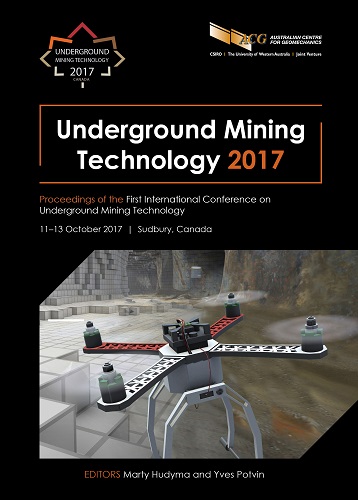Lessons learnt from egress drift excavation through a minor pillar in an extraction level, Deep Ore Zone mine, Freeport Indonesia, Papua

|
Authors: Firmanulhaq, SA; Kamarea, J; Hasan, R; Putra, F; Salim, F |
DOI https://doi.org/10.36487/ACG_rep/1710_53_Firmanulhaq
Cite As:
Firmanulhaq, SA, Kamarea, J, Hasan, R, Putra, F & Salim, F 2017, 'Lessons learnt from egress drift excavation through a minor pillar in an extraction level, Deep Ore Zone mine, Freeport Indonesia, Papua', in M Hudyma & Y Potvin (eds), UMT 2017: Proceedings of the First International Conference on Underground Mining Technology, Australian Centre for Geomechanics, Perth, pp. 645-654, https://doi.org/10.36487/ACG_rep/1710_53_Firmanulhaq
Abstract:
The Deep Ore Zone (DOZ) mine is one of Freeport Indonesia’s block cave mines with maximum production of 40,000 tpd (2016) from 650 active drawpoints. Damage leading to ground collapse was well understood as one of the major factors causing production interruption. Ground collapses had different characteristics and severity, so challenges and objectives of the rehab works are varied. Rehabilitation of ground collapse is not only performed to achieve production targets, but is also related to ventilation, access, and cost. Causes of collapse of the 90 m long panel 02 drawpoint 17 to 21 west were identified as a combination of geological features (structure), load static, and ground support resistance. Due to the collapsed area being surrounded by very wet and fine materials from the drawpoint (mud rush potential), and considering previous rehabilitation rate performance, excavation of an egress drift (only for man access) through a minor pillar from panel 02 to panel 01 was the decided as a reasonable alternative. The excavation of the egress drift through unidentified pillar conditions and below load static cave material requires more investigation to achieve a suitable project outcome. Borehole camera survey and numerical modelling helped geotechnical engineers to identify the hazards in terms of drift stability and support system. This paper presents the lesson learnt during the assessment and excavation works.
Keywords: collapsed drift, minor pillar, egress drift, block cave, safety, modelling
References:
Abel, JF 1988, ‘Soft rock pillars’, International Journal of Mining and Geological Engineering, vol. 6, no. 3, pp. 215–248.
Barton, N, Lien, R & Lunde, J 1974, ‘Engineering classification of rock masses for the design of tunnel support’, Rock Mechanics, vol. 6, no. 4, pp. 189–236.
Basson, U 2000, Imaging of Active Fault Zone in the Dead Sea Rift: Evrona Fault Zone as a Case Study, PhD dissertation, Tel Aviv University, Tel Aviv.
Bieniawaski, Z 1989, Engineering Rock Mass Classification: A Complete Manual for Engineers and Geologist in Mining, Civil and Petroleum Engineering, John Willey & Sons, New York.
Coutts, BP, Susanto, H, Belluz, N, Flint, D & Edwards, A 1999, ‘Geology of the Deep Ore Zone, Ertsberg East Skarn System, Irian Jaya’, Proceedings of the International Congress on Earth Science, Exploration and Mining Around the Pacific Rim: PACRIM ’99, The Australasian Institute of Mining and Metallurgy, Melbourne, pp. 539–547.
Rachmad, L & Widijanto, E 2000, ‘Application of convergence monitoring at PT Freeport Indonesia Deep Ore Zone Mine’,
in R Hammah, W Bawden, J Curran & M Telesnicki (eds), Proceedings of the 5th North American Rock Mechanics Symposium and 17th Tunneling Association of Canada Conference, University of Toronto Press, Toronto, pp. 181–188.
Widijanto, E 2006, ‘Geotechnical challenges in the DOZ block cave mine’, in CF Leung & YX Zhou (eds), Proceedings of the 4th Asian Rock Mechanics Symposium: Rock Mechanic in Underground Construction, World Scientific Publishing Co. Pte. Ltd., Singapore, pp. 210–216.
© Copyright 2025, Australian Centre for Geomechanics (ACG), The University of Western Australia. All rights reserved.
View copyright/legal information
Please direct any queries or error reports to repository-acg@uwa.edu.au
View copyright/legal information
Please direct any queries or error reports to repository-acg@uwa.edu.au